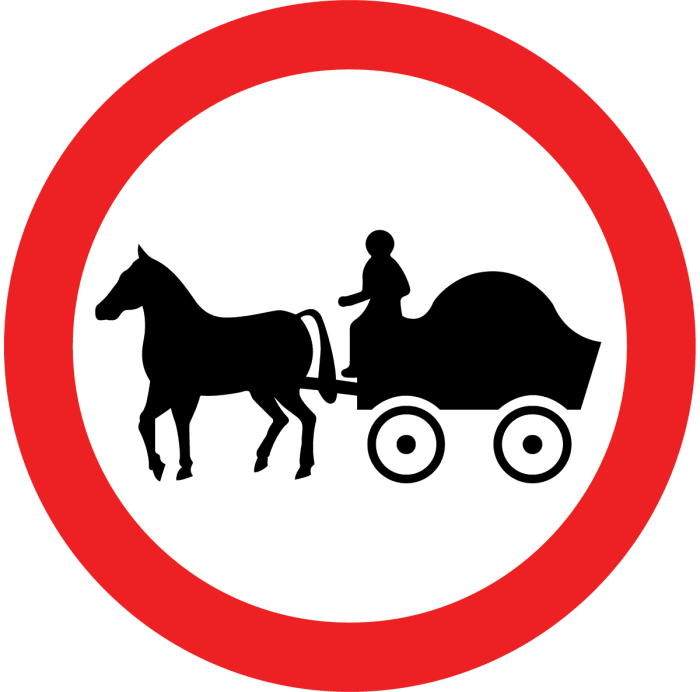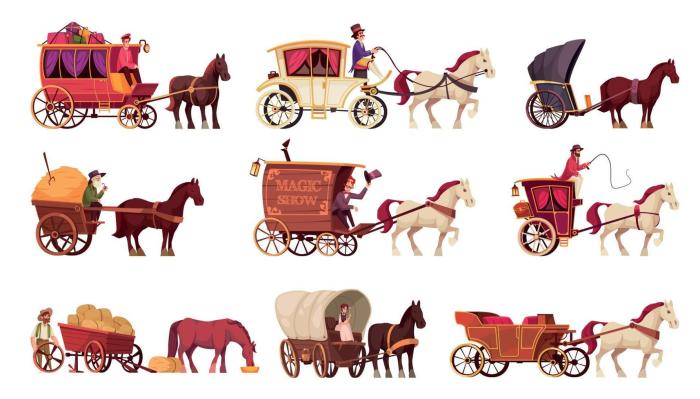Horse drawn vehicles are not allowed on public roadways – In the realm of transportation, the use of horse-drawn vehicles on public roadways has been a subject of debate, leading to their eventual prohibition. This article delves into the historical significance, safety concerns, and alternatives to horse-drawn vehicles, exploring the reasons behind their restricted use and the impact on owners and users.
The history of horse-drawn vehicles is intertwined with the development of human transportation, serving as a primary mode of travel for centuries. From chariots to carriages, these vehicles played a crucial role in commerce, warfare, and daily life. However, with the advent of motorized vehicles, safety concerns and traffic congestion prompted regulations and laws restricting their use on public roadways.
History of Horse-Drawn Vehicles on Public Roadways

Horse-drawn vehicles have played a significant role in transportation throughout history. From ancient chariots to the stagecoaches of the Wild West, these vehicles have served as a primary mode of transportation for people and goods.
In the 19th century, horse-drawn vehicles reached their peak in popularity. Cities were crowded with omnibuses, carriages, and wagons, and horses provided the primary means of pulling heavy loads.
The use of horse-drawn vehicles on public roadways was governed by a variety of regulations and laws. These regulations typically addressed issues such as traffic safety, animal welfare, and the cleanliness of the streets.
Reasons for the Prohibition of Horse-Drawn Vehicles on Public Roadways

The use of horse-drawn vehicles on public roadways declined in the early 20th century with the advent of the automobile. However, in some areas, horse-drawn vehicles continued to be used for transportation and recreation.
There are a number of reasons why horse-drawn vehicles are no longer allowed on public roadways in most jurisdictions. These reasons include:
- Safety concerns: Horse-drawn vehicles are much slower than other vehicles, and they can be difficult to maneuver in traffic. This can create safety hazards for both the occupants of the horse-drawn vehicle and other road users.
- Environmental impact: Horses produce a significant amount of manure, which can pollute the environment. In addition, the use of horses for transportation can contribute to traffic congestion.
- Traffic congestion: Horse-drawn vehicles are slow-moving, and they can cause traffic congestion, especially in urban areas.
Alternatives to Horse-Drawn Vehicles: Horse Drawn Vehicles Are Not Allowed On Public Roadways

There are a number of alternatives to horse-drawn vehicles that can be used for transportation and recreation. These alternatives include:
- Automobiles: Automobiles are the most common alternative to horse-drawn vehicles. They are fast, efficient, and relatively safe.
- Bicycles: Bicycles are a good option for short-distance travel. They are relatively inexpensive and easy to operate.
- Public transportation: Public transportation is a good option for people who do not have access to a car or who do not want to drive. Public transportation can be less expensive than owning and operating a car.
Impact of the Prohibition on Horse-Drawn Vehicle Owners and Users

The prohibition of horse-drawn vehicles on public roadways has had a significant impact on horse-drawn vehicle owners and users. For some people, the prohibition has meant that they have had to give up a way of life. For others, it has meant that they have had to find new ways to get around.
The prohibition has also had a cultural and historical impact. Horse-drawn vehicles are a reminder of a bygone era, and their disappearance from public roadways has changed the look and feel of many communities.
In some cases, exemptions or accommodations have been made for certain types of horse-drawn vehicles. For example, some jurisdictions allow horse-drawn carriages to operate in tourist areas. In other cases, horse-drawn vehicles are allowed to be used for agricultural purposes.
Essential FAQs
Why are horse-drawn vehicles not allowed on public roadways?
Horse-drawn vehicles pose safety concerns due to their slower speed, limited visibility, and potential for animal unpredictability. They also contribute to traffic congestion and environmental impact.
What are the alternatives to horse-drawn vehicles?
Alternatives to horse-drawn vehicles include motorized vehicles such as cars, buses, and trains, as well as non-motorized options like bicycles and rickshaws.
What is the impact of the prohibition on horse-drawn vehicle owners and users?
The prohibition has had economic consequences for owners and users, as well as cultural and historical implications. However, it has also improved safety and traffic flow.